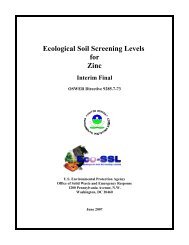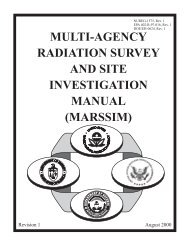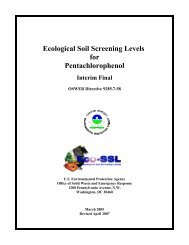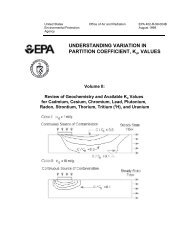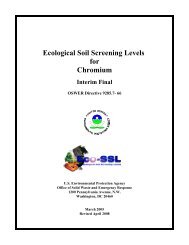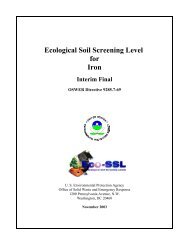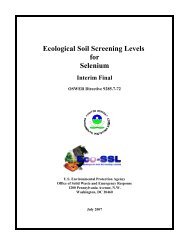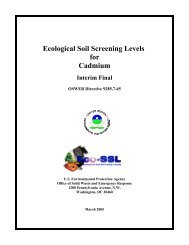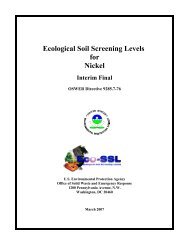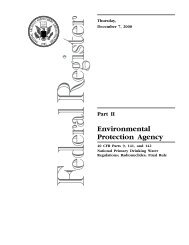Guidance for Conducting Risk Assessments and Related Risk ...
Guidance for Conducting Risk Assessments and Related Risk ...
Guidance for Conducting Risk Assessments and Related Risk ...
You also want an ePaper? Increase the reach of your titles
YUMPU automatically turns print PDFs into web optimized ePapers that Google loves.
fail the screening. If the chemicals present at a site pass this screening, it is simply an indication that<br />
further assessment should be conducted to determine the need <strong>for</strong> continued investigation.<br />
5.2 INTEGRATION POINT ASSESSMENTS<br />
For the ORR sites, the majority of any off-site public exposure to chemicals of potential concern<br />
results from exposure to contaminants in surface water because surface water is the primary receiving<br />
medium in <strong>and</strong> around the reservation. Other potential receiving media, such as agricultural products, air,<br />
<strong>and</strong> groundwater, are currently not primary exposure media. The integration point assessment, which<br />
supports watershed actions, is designed to actively use monitoring, surveillance, compliance, <strong>and</strong><br />
Remedial Investigation (RI) data to evaluate off-site risk from a variety of sources that input into the<br />
surface water integrator. The data will be used to:<br />
• establish a baseline <strong>for</strong> evaluating the risk at different points within the integrators;<br />
• identify <strong>and</strong> prioritize sites within the context of the integrator; <strong>and</strong><br />
• estimate the potential risk reduction resulting from an action to control contaminant sources.<br />
Note: The integration point assessment provides critical in<strong>for</strong>mation to the baseline human health risk<br />
assessment because of frequent updates (as data become available). As the integration point assessment is<br />
updated, the results are used to provide current estimates of potential risk/hazard at the surface water or<br />
watershed level.<br />
The integration point assessment is a flux-based screening assessment. Flux is defined as the mass<br />
of chemical that migrates through a cross-sectional area in a given time. Flux is important because of the<br />
number of actual <strong>and</strong> potential sources of chemicals that exist on the ORR. In addition, there is<br />
considerable variability in flow rates of the different surface water systems that transport these chemicals<br />
to the surface water integrator sites <strong>and</strong> eventually to the Clinch River (near the ORR). Controlling<br />
sources of contamination at areas with high fluxes of integrator chemical of concern (COCs) is the<br />
quickest means of reducing contaminant concentrations in off-site areas to target levels.<br />
One of the more important objectives during early phases of an integrator site investigation is to<br />
assimilate available in<strong>for</strong>mation from existing programs to estimate fluxes <strong>and</strong> mass balances of<br />
chemicals within the integrator system. The in<strong>for</strong>mation is then used to assess fluxes within the<br />
watershed <strong>and</strong> compare them to fluxes that input into public access areas in order to differentiate between<br />
various contaminant sources at the ORR. Mass balance in<strong>for</strong>mation is important <strong>for</strong> describing the<br />
accumulation <strong>and</strong> discharge of chemicals within a system where inputs <strong>and</strong> outputs are known. The<br />
integration point assessment allows communication of this in<strong>for</strong>mation in terms of risk to the public <strong>and</strong><br />
risk managers. It also provides an important link between the risk posed by contamination at source<br />
locations <strong>and</strong> risk posed by contamination in surface water integrators so that the impact of actions to<br />
control contaminant fluxes at sources can be evaluated at the integrator or watershed level. Appendix I<br />
provides a detailed description of the integration point assessment methods.<br />
32



